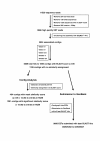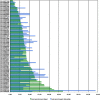Analysis of newly established EST databases reveals similarities between heart regeneration in newt and fish
- PMID: 20047682
- PMCID: PMC2823690
- DOI: 10.1186/1471-2164-11-4
Analysis of newly established EST databases reveals similarities between heart regeneration in newt and fish
Abstract
Background: The newt Notophthalmus viridescens possesses the remarkable ability to respond to cardiac damage by formation of new myocardial tissue. Surprisingly little is known about changes in gene activities that occur during the course of regeneration. To begin to decipher the molecular processes, that underlie restoration of functional cardiac tissue, we generated an EST database from regenerating newt hearts and compared the transcriptional profile of selected candidates with genes deregulated during zebrafish heart regeneration.
Results: A cDNA library of 100,000 cDNA clones was generated from newt hearts 14 days after ventricular injury. Sequencing of 11520 cDNA clones resulted in 2894 assembled contigs. BLAST searches revealed 1695 sequences with potential homology to sequences from the NCBI database. BLAST searches to TrEMBL and Swiss-Prot databases assigned 1116 proteins to Gene Ontology terms. We also identified a relatively large set of 174 ORFs, which are likely to be unique for urodele amphibians. Expression analysis of newt-zebrafish homologues confirmed the deregulation of selected genes during heart regeneration. Sequences, BLAST results and GO annotations were visualized in a relational web based database followed by grouping of identified proteins into clusters of GO Terms. Comparison of data from regenerating zebrafish hearts identified biological processes, which were uniformly overrepresented during cardiac regeneration in newt and zebrafish.
Conclusion: We concluded that heart regeneration in newts and zebrafish led to the activation of similar sets of genes, which suggests that heart regeneration in both species might follow similar principles. The design of the newly established newt EST database allows identification of molecular pathways important for heart regeneration.
Figures






Similar articles
-
Newt-omics: a comprehensive repository for omics data from the newt Notophthalmus viridescens.Nucleic Acids Res. 2012 Jan;40(Database issue):D895-900. doi: 10.1093/nar/gkr873. Epub 2011 Oct 27. Nucleic Acids Res. 2012. PMID: 22039101 Free PMC article.
-
An Ambystoma mexicanum EST sequencing project: analysis of 17,352 expressed sequence tags from embryonic and regenerating blastema cDNA libraries.Genome Biol. 2004;5(9):R67. doi: 10.1186/gb-2004-5-9-r67. Epub 2004 Aug 13. Genome Biol. 2004. PMID: 15345051 Free PMC article.
-
Molecular cloning of the Notophthalmus viridescens radical fringe cDNA and characterization of its expression during forelimb development and adult forelimb regeneration.Dev Dyn. 1999 Mar;214(3):259-68. doi: 10.1002/(SICI)1097-0177(199903)214:3<259::AID-AJA9>3.0.CO;2-G. Dev Dyn. 1999. PMID: 10090152
-
Newt opportunities for understanding the dedifferentiation process.ScientificWorldJournal. 2006 Jul 7;6 Suppl 1:55-64. doi: 10.1100/tsw.2006.327. ScientificWorldJournal. 2006. PMID: 17205187 Free PMC article. Review.
-
Expression of five homeobox genes in the adult newt appendages and regeneration blastemas.Prog Clin Biol Res. 1993;383A:41-50. Prog Clin Biol Res. 1993. PMID: 7905640 Review.
Cited by
-
A de novo assembly of the newt transcriptome combined with proteomic validation identifies new protein families expressed during tissue regeneration.Genome Biol. 2013 Feb 20;14(2):R16. doi: 10.1186/gb-2013-14-2-r16. Genome Biol. 2013. PMID: 23425577 Free PMC article.
-
A Systematic Exposition of Methods used for Quantification of Heart Regeneration after Apex Resection in Zebrafish.Cells. 2020 Feb 26;9(3):548. doi: 10.3390/cells9030548. Cells. 2020. PMID: 32111059 Free PMC article.
-
Networks that Govern Cardiomyocyte Proliferation to Facilitate Repair of the Injured Mammalian Heart.Methodist Debakey Cardiovasc J. 2023 Nov 16;19(5):16-25. doi: 10.14797/mdcvj.1300. eCollection 2023. Methodist Debakey Cardiovasc J. 2023. PMID: 38028968 Free PMC article. Review.
-
Genome-wide association and prediction of direct genomic breeding values for composition of fatty acids in Angus beef cattle.BMC Genomics. 2013 Oct 25;14:730. doi: 10.1186/1471-2164-14-730. BMC Genomics. 2013. PMID: 24156620 Free PMC article.
-
Deep sequencing-based transcriptome profiling analysis of bacteria-challenged Lateolabrax japonicus reveals insight into the immune-relevant genes in marine fish.BMC Genomics. 2010 Aug 13;11:472. doi: 10.1186/1471-2164-11-472. BMC Genomics. 2010. PMID: 20707909 Free PMC article.
References
Publication types
MeSH terms
LinkOut - more resources
Full Text Sources
Research Materials

